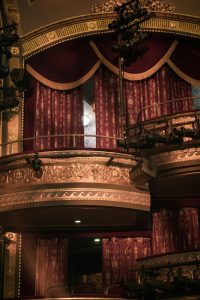Women Organists in Victorian Fiction
Part 1
The image of music in fiction, especially involving women musicians, offers a rich area of discourse for scholars of Victorian literature. Mary Burgan, Paula Gillett, Phyllis Weliver and contributors to a collection of essays edited by Sophie Fuller and Nicky Losseff, for example, all have investigated how women’s music making is portrayed in Victorian novels, but from different perspectives. 1 For Weliver the discrepancies between fiction’s portrayal of musical women and actual trends in music making reveal how literature dialogued with real life, either encouraging or condemning music’s traditional place in women’s lives. Burgan and Jodi Lustig focus on the piano and what it signifies for the young women who play it. Burgan has found that over the course of the nineteenth-century, the piano served as a social prop, a symbol of confinement and an instrument of rebellion in women’s lives. Lustig considers how the piano in one Victorian novel signifies its antithesis in another. She explains: ‘The instrument comes to represent a set of conventions, codes and ideologies which Victorian culture reifies, and proves the consummate site for authors to stage, contest, and shape their construction.’ 2 In her work on highly contested perceptions of female musicians in late-nineteenth-century English culture, Gillett includes fiction about singers and violinists among the fruitful sources by which to understand women’s participation in late Victorian musical culture.
The musical lives of fictional women pianists, singers and violinists have been examined for the complexity of meanings their music making conveyed, but women organists have not been subjected to comparable scrutiny, in part because they are fewer in number. But Weliver has found a rare example of a woman organist at the keyboard in Lady Audley’s Secret by Mary Elizabeth Braddon. As Robert Audley enters a rural churchyard, he hears ‘the slow harmonies of a dreamy melody that sounded like an extemporare composition of an accomplished player’. Curious to see this new organist ‘who can afford to bury his talents at Audley, and play Mendelssohn’s finest fugues for a stipend of sixteen pounds a year’, Robert waits for the organist to descend from the organ loft. Much to his surprise, the he is a she – Clara Talboys. 3 That the male character mistakes the woman organist for a man is noteworthy. As Weliver poses, mid-Victorian female organists might be signs of sexual transgression and danger. The organ loft was considered a man’s domain, and, as explained by William Crotch in 1831, fugues were thought of as masculine music, a concept perpetuated in the Victorian code of sexual aesthetics. 4
In another notable exception, Fancy Day in Under the Greenwood Tree by Thomas Hardy is an organist. As Dick Dewy, a member of the Mellstock parish choir who has fallen in love with her, discovers after much serious meditation, Fancy is better known for her ability to turn heads than for her ability as a musician. The new vicar, Mr Maybold, had brought an organ to the Mellstock parish church to replace the gallery choir and chose Fancy, who was the new schoolmistress, as his organist. But Dick now understood that ‘she was, if not a flirt, a woman who had no end of admirers; a girl most certainly too anxious about her frocks; a girl, whose feelings, though warm, were not deep; a girl who cared a great deal too much about how she appeared in the eyes of other men’. Thus it is not surprising that on the first Sunday that Fancy was to play for the church service, we are told, ‘If ever a woman looked a divinity, Fancy Day appeared one that morning as she floated down those school steps, in a form of nebulous collection of colours inkling to blue. With an audacity unparalleled in the whole history of village-schoolmistresses at this date – partly owing, no doubt, to papa’s respectable accumulation of cash, which rendered her profession not altogether one of necessity – she had actually donned a hat and feather and lowered her hitherto plainly looped-up hair, which now fell about her shoulders in a profusion of curls.’ 5
When Fancy took her place on the organ stool in full view of the vicar in his pulpit and the congregation in their pews, her appearance elicited mixed reactions. The lovesick Mr Maybold was not at all angry about her appearance. Fancy’s proximity was a strange delight to him, and ‘he gloried in her musical success that morning in a spirit quite beyond a mere cleric’s glory at the inauguration of a new order of things’. But members of the congregation were not equally impressed. ‘“Good heavens – disgraceful! Curls and a hat and feathers!” said the daughters of the small gentry, who had either only curly hair without a hat and feather, or a hat and feather without curly hair. “A bonnet for church always!” said sober matrons.’ 6
While not commonly found in novels, women organists are heroines in shorter works of Victorian fiction, such as in stories printed in The Girl’s Own Paper. Published by the Religious Tract Society beginning in 1880, The Girl’s Own Paper differed from other magazines. This popular weekly included the organ among its articles on how to sing and to play musical instruments, and included organists among female characters in its fiction. The other instruments were piano, harp, harmonium, concertina, violin guitar, banjo and zither. But unlike their sister instrumentalists, organists by necessity practiced and performed in public spaces. Given the Victorian belief that a woman’s music making belonged within the home circle, advocacy of organ playing by women could be problematic. In its role as literary guardian of morality, The Girl’s Own Paper sought to guide its readers between competing demands of desire for at least a modicum of musical independence and of duty to comply with societal injunctions about music making. 7 Just how the magazine achieved an acceptable solution to this musical dilemma in the case of female organists, and the musical messages it conveyed to its readers, are the topics of my next blog.
Notes
1 Mary Burgan, ‘Heroines at the Piano: Women and Music in Nineteenth-Century Fiction’, in The Lost Chord: Essays on Victorian Music, ed. Nicholas Temperley, 42–67 (Bloomington: Indiana University Press, 1989); Paula Gillett, Musical Women in England, 1870–1914: ‘Encroaching on All Man’s Privileges’ (New York: St Martin’s, 2000); Phyllis Weliver, Women Musicians in Victorian Fiction, 1860 – 1900: Representations of Music, Science and Gender in the Leisured Home (Aldershot and Burlington, VT: Ashgate, 2000); Sophie Fuller and Nicky Losseff, eds, The Idea of Music in Victorian Fiction (Aldershot and Burlington, VT: Ashgate, 2004).
2 Jodi Lustig, ‘The Piano’s Progress: The Piano in Play in the Victorian Novel’, in Fuller and Losseff, The Idea of Music, 84.
3 Mary Elizabeth Braddon, Lady Audley’s Secret [1862], ed. David Kilton (Oxford and New York: Oxford University Press, 1987), 255–57.
4 William Crotch, ‘Substance of Several Courses of Lectures on Music, read in the University of Oxford and in the Metropolis (London), chs. 1–3’, in Music and Aesthetics in the Eighteenth and Early-Nineteenth Centuries, ed. Peter le Huray and James Day (Cambridge: Cambridge University Press, 1981), 431–32, 435.
5 Thomas Hardy, Under the Greenwood Tree [1872] (Macmillan: London, Melbourne and Toronto, and New York: St Martin’s, 1966), 146, 170.
6 Ibid., 173, 172.
7 See Judith Barger, Music in The Girl’s Own Paper: An Annotated Catalogue, 1880–1910 (London and New York: Routledge, 2017).
To be continued



